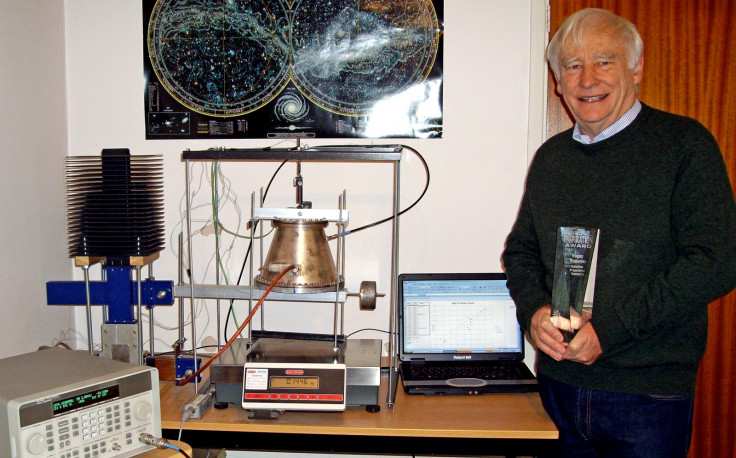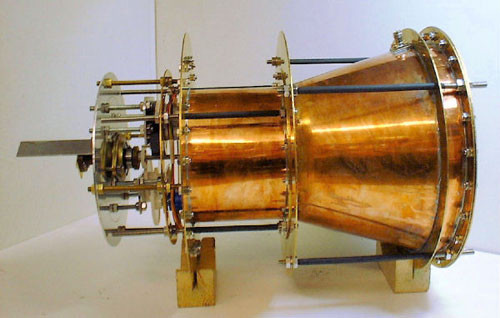EmDrive: Nasa Eagleworks' paper has finally passed peer review, says scientist in the know
Dr José Rodal says the paper has been accepted by the American Institute of Aeronautics and Astronautics.
An independent scientist has confirmed that the paper by scientists at the Nasa Eagleworks Laboratories on achieving thrust using highly controversial space propulsion technology EmDrive has passed peer review, and will soon be published by the American Institute of Aeronautics and Astronautics (AIAA).
- [UPDATE - 14:06 BST, 5 August 2016] EmDrive: Guido Fetta sending his Cannae Drive into space on a satellite to see if it works
- [UPDATE - 19:01 BST, 2 August 2016] EmDrive: AIAA confirms release date of controversial Nasa Eagleworks space propulsion paper
- [Simplified explainer] What is the EmDrive and why should I care?
Dr José Rodal posted on the Nasa Spaceflight forum – in a now-deleted comment – that the new paper will be entitled "Measurement of Impulsive Thrust from a Closed Radio Frequency Cavity in Vacuum" and is authored by "Harold White, Paul March, Lawrence, Vera, Sylvester, Brady and Bailey".
There is also a line of text that EmDrive enthusiasts believe could be from the paper's abstract, which reads: "Thrust data in mode shape TM212 at less than 810<sup>6 Torr environment, from forward, reverse and null tests suggests that the system is consistently performing with a thrust to power ratio of 1.2 +/- 0.1 mN/Kw ()".
Rodal also revealed that the paper will be published in the AIAA Journal of Propulsion and Power, a prominent journal published by the AIAA, which is one of the world's largest technical societies dedicated to aerospace innovations.
Eagleworks is an experimental lab that is to Nasa essentially what the secretive Google X "moonshot" R&D lab is to Google/Alphabet, and the space agency is not yet ready to place its official stamp of approval on a technology many still believe does not work.
Although Eagleworks engineer Paul March has posted several updates on the ongoing research to the Nasa Spaceflight forum showing that repeated tests conducted on the EmDrive in a vacuum successfully yielded thrust results that could not be explained by external interference, those in the international scientific community who doubt the feasibility of the technology have long believed real results of thrust by Eagleworks would never see the light of day.
In March, the same Eagleworks engineer announced that their paper was going through the peer review process, but they had no idea when it would be published as "peer reviews are glacially slow".
However, it seems that the wait might finally be over, if Rodal, a long-time supporter of the EmDrive who is building his own version of the Nasa aluminium frustum, is to be believed.
Research for the UK government has finally been declassified

Roger Shawyer is the British scientist who first proposed the concept of EmDrive in 1999, and was ridiculed and even accused of fraud by some in the international space community despite his work being funded by the UK government and licenced by Boeing.
How the EmDrive works
The EmDrive is the invention of British scientist Roger Shawyer, who proposed in 1999 that based on the theory of special relativity, electricity converted into microwaves and fired within a closed cone-shaped cavity causes the microwave particles to exert more force on the flat surface at the large end of the cone (i.e. there is less combined particle momentum at the narrow end due to a reduction in group particle velocity), thereby generating thrust.
His critics say that according to the law of conservation of momentum, his theory cannot work as in order for a thruster to gain momentum in one direction, a propellant must be expelled in the opposite direction, and the EmDrive is a closed system.
However, Shawyer claims that following fundamental physics involving the theory of special relativity, the EmDrive does in fact preserve the law of conservation of momentum and energy.
Shawyer believes EmDrive could transform the aerospace industry and potentially solve both the energy crisis and climate change, while also speeding up space travel by making it much cheaper to launch satellites and spacecraft into orbit. He is also actively working to test the technology out on unmanned aerial vehicles (UAV), in the hope of creating feasible flying cars.
He told IBTimes UK that he is as excited as other EmDrive enthusiasts to read the upcoming paper by Nasa Eagleworks, but adds that any thrust measured will be very small, probably equivalent to where Shawyer's research was a decade ago.
Incidentally, the 10-year-long rule about classifying research done for the UK government has now expired, and Shawyer has made four papers publicly accessible on his website for anyone to read.
"I daresay America will have a lot to say about it, but it's not really new. It's all been done before 10 years ago. If you bother to go through the [declassified] papers, you can see the levels of thrust we achieved are significantly higher than the levels of thrust that Nasa Eagleworks has got," he said.
"People all around the world have been measuring thrust. You've got guys building them in their garages and very large organisations building cavities too. They're all generating thrust, there's no great mystery. People think it's black magic or something, but it's not. Any physicist worth his salt should understand how it works, or if they don't, they should change their profession."
Shawyer pushing ahead with EmDrive 2.0

Shawyer is now actively working on the second-generation EmDrive with an unnamed UK aerospace company and the new device is meant to be able to achieve tonnes of thrust (1T = 1,000kg), rather than just a few grams.
"We're trying to achieve thrust levels that go up by many orders of magnitude, where the q values of the cavities are between 1 x 10<sup>9 and 5 x 10<sup>4. Once you reach the levels of thrust we anticipate we will reach, you can apply it anywhere," he told IBTimes UK. "Essentially, anything that currently flies or drives or floats can use EmDrive technology."
Despite the increasing interest in EmDrive, the fact that he will soon be vindicated and how in July 2015 his own paper describing space propulsion on drones passed peer review, Shawyer does not plan to release anymore papers for quite a while.
"The work we're doing is difficult and expensive and the people paying for it don't necessarily want to give it away to the rest of the world, but EmDrive will make a huge impact and a lot of people have thought of a lot of things to apply it to," he said.
Recently, several scientists including Dr Mike McCulloch of Plymouth University and Dr Arto Annila from the University of Helsinki have been using exotic physics to try to explain why the EmDrive works, and they have seen that the thrust detected in experiments by Shawyer and other scientists matches their theoretical calculations.
IBTimes UK has contacted AIAA for a statement, but had received no response as of press time.
© Copyright IBTimes 2025. All rights reserved.






















